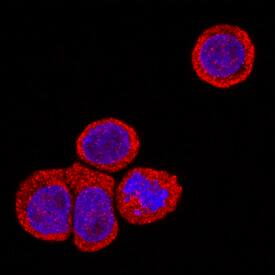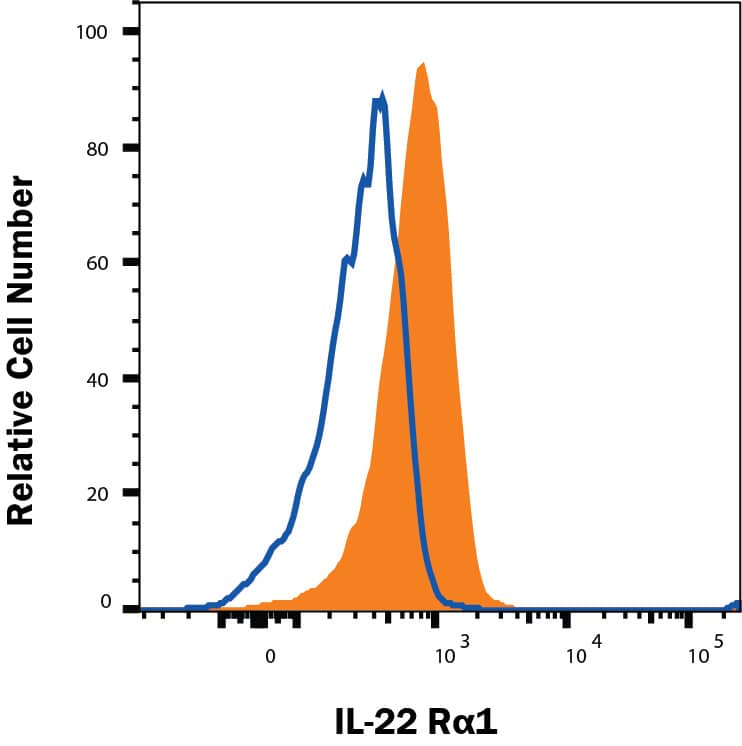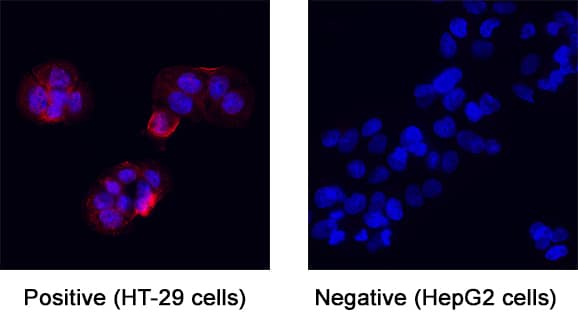Human IL-22 R alpha1 Antibody
R&D Systems, part of Bio-Techne | Catalog # MAB2770


Key Product Details
Species Reactivity
Validated:
Cited:
Applications
Validated:
Cited:
Label
Antibody Source
Product Specifications
Immunogen
Pro18-Thr228
Accession # Q8N6P7
Specificity
Clonality
Host
Isotype
Scientific Data Images for Human IL-22 R alpha1 Antibody
Detection of IL‑22 R alpha1 in COLO 205 Human Cell Line by Flow Cytometry.
COLO 205 human colorectal adenocarcinoma cell line was stained with Mouse Anti-Human IL-22 Ra1 Monoclonal Antibody (Catalog # MAB2770, filled histogram) or isotype control antibody (MAB002, open histogram), followed by Phycoerythrin-conjugated Anti-Mouse IgG Secondary Antibody (F0102B).IL‑22 R alpha1 in HT‑29 Human Cell Line.
IL-22 Ra1 was detected in immersion fixed HT-29 human colon adenocarcinoma cell line using Mouse Anti-Human IL-22 Ra1 Monoclonal Antibody (Catalog # MAB2770) at 10 µg/mL for 3 hours at room temperature. Cells were stained using the Northern-Lights™ 557-conjugated Anti-Mouse IgG Secondary Antibody (red; NL007) and counterstained with DAPI (blue). View our protocol for Fluorescent ICC Staining of Cells on Coverslips.Detection of IL-22 R alpha1 in HT-29 cells by Flow Cytometry.
HT-29 cells were stained with Mouse Anti-Human IL-22 R alpha1 Monoclonal Antibody (Catalog # MAB2770, filled histogram) or isotype control antibody (Catalog # MAB002, open histogram), followed by Phycoerythrin-conjugated Anti-Mouse IgG Secondary Antibody (Catalog # F0102B). View our protocol for Staining Membrane-associated Proteins.Applications for Human IL-22 R alpha1 Antibody
CyTOF-ready
Flow Cytometry
Sample: COLO 205 human colorectal adenocarcinoma cell line and HT-29 human colon adenocarcinoma cell line
Immunocytochemistry
Sample: Immersion fixed HT‑29 Human Colon Adenocarcinoma Cell Line (Positive) and Daudi Human Burkitt's Lymphoma Cell Line (Negative) Cells
Reviewed Applications
Read 2 reviews rated 4 using MAB2770 in the following applications:
Formulation, Preparation, and Storage
Purification
Reconstitution
Formulation
Shipping
Stability & Storage
- 12 months from date of receipt, -20 to -70 °C as supplied.
- 1 month, 2 to 8 °C under sterile conditions after reconstitution.
- 6 months, -20 to -70 °C under sterile conditions after reconstitution.
Background: IL-22 R alpha 1
IL-22 receptor, also known as IL-22 R alpha1 and CRF2-9, is an approximately 65 kDa transmembrane glycoprotein in the type II cytokine receptor family (CRF). IL-22 R alpha1 contains a 211 amino acid (aa) extracellular domain (ECD) with two fibronectin type III repeats, and a 323 aa cytoplasmic domain. IL-22 R alpha1 associates with either IL-10 R beta or IL-20 R beta to form receptor complexes with distinct ligand selectivities. IL-10 R beta is a shared subunit of the IL-10, -22, -26, -28, and -29 receptors, while IL-20 R beta is a shared subunit of the IL-19, -20, -22R and -24 receptors (1). IL-22 R alpha1/IL-10 R beta is an IL-22 responsive receptor (2, 3), and IL-22 R alpha1/IL-20 R beta is an IL-20 or IL-24 responsive receptor (4, 5). IL-22 R alpha1 contains cytoplasmic motifs for interactions with signal transduction molecules, but formation of ternary complexes with IL-10 R beta or IL-20 R beta and the respective ligands is required for signal transduction (2, 6). IL-22BP functions as a competitive antagonist by binding IL-22 and preventing its association with IL-22 R alpha1 (7, 9). Even though it is a receptor for interleukins, IL-22 R alpha1 is not expressed on hematopoietic cells (6, 10, 11). Instead, IL-22 R alpha1 expression is restricted to epithelial and stromal cells (6, 10‑13). IL-22 R alpha1 signaling promotes innate immune responses and wound healing at sites of infection and inflammation. This includes upregulation of antimicrobial, acute phase, proinflammatory, and extracellular matrix proteins as well as proteases (3, 11, 13, 14). IL-22 R alpha1 signaling also promotes downregulation of proteins involved in keratinocyte differentiation (3, 14). Within the ECD, human IL-22 R alpha1 shares 78%, 76%, and 83% aa sequence identity with mouse, rat, and canine IL-22 R, respectively. It shares 22%‑25% aa sequence identity with the ECDs of other class II receptors IL-10 R, IL-20 R, and IL-28 R.
References
- Langer, J.A. et al. (2004) Cytokine Growth Factor Rev. 15:33.
- Xie, M.-H. et al. (2000) J. Biol. Chem. 275:31335.
- Boniface, K. et al. (2005) J. Immunol. 174:3695.
- Dumoutier, L. et al. (2001) J. Immunol. 167:3545.
- Wang, M. et al. (2002) J. Biol. Chem. 277:7341.
- Kotenko, S.V. et al. (2001) J. Biol. Chem. 276:2725.
- Li, J. et al. (2004) Int. Immunopharmacol. 4:693.
- Logsdon, N.J. et al. (2002) J. Interferon Cytokine Res. 22:1099.
- Kotenko, S.V. et al. (2001) J. Immunol. 166:7096.
- Nagalakshmi, M.L. et al. (2004) Int. Immunopharmacol. 4:577.
- Nagalakshmi, M.L. et al. (2004) Int. Immunopharmacol. 4:679.
- Aggarwal, S. et al. (2001) J. Interferon Cytokine Res. 21:1047.
- Wolk, K. et al. (2004) Immunity 21:241.
- Wolk, K. et al. (2006) Eur. J. Immunol. 36:1309.
Long Name
Alternate Names
Gene Symbol
UniProt
Additional IL-22 R alpha 1 Products
Product Documents for Human IL-22 R alpha1 Antibody
Product Specific Notices for Human IL-22 R alpha1 Antibody
For research use only



